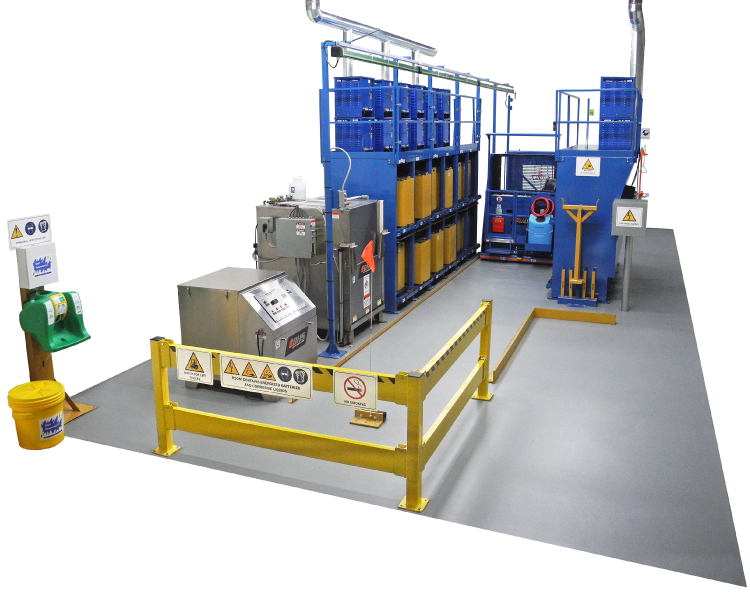We use cookies to make your experience better. To comply with the new e-Privacy directive, we need to ask for your consent to set the cookies. Learn more.
How to Avoid Acid Damage in the Battery Room
Forklift batteries are essentially giant tubs of acid. While you can't prevent the occasional drip or spill, you can — and definitely should — protect your floors and equipment from the caustic effects of battery electrolyte.
According to the Portland Cement Association, concrete is particularly vulnerable to acids. Acidic liquid drains into the pores in concrete and eats away at flooring. This is disastrous in battery rooms, where forklifts and battery handling equipment require smooth, superflat floors to function efficiently.
It’s not just the floor you need to worry about; crucial battery room equipment is also vulnerable to corrosive residue. Make sure you protect the following at-risk items from acid spills and boil-overs:
-
Battery stands, especially when not protected by an acid-resistant coating.
-
Battery cases themselves. Corrosive build-up is one reason that periodic washing is such an important maintenance task.
-
Battery room staff. Chemical burns are no joke, and when battery acid isn't properly contained, your staff is at risk of serious injury.
-
Battery changers. Make sure that the beds in your battery handling equipment include acid resistant rollers or slide strips.

-
Install drip pans in battery stands.
Choose a pan that's made of corner-formed stainless steel, like BHS Drip Pan Kits (DP & DK). Welded seams sometimes crack and let electrolyte through to accumulate on stands and floors, so corner-formed construction is crucial.
-
Add an additional layer of protection with acid-neutralizing pads.
AcidSorb Pillows from BHS are designed to fill drip pans. They absorb acid drips and spills, containing and neutralizing the substance. When the pads fully neutralize acids, they change color to let you know it's safe to dispose of them (according to all federal and local regulations, of course).One warning: while AcidSorb Pillows are great at containing sulfuric acid spills, they're not designed to handle hydrofluoric acid (HF). Don't use them with compounds that contain HF.
-
Choose battery stands with an acid-resistant coating.
The finish on your system stands may look nice, but it should also be your first line of defense against acid attacks. BHS System Stands are made of durable stainless steel with an acid-resistant powder coating. If your stands are made of bare steel, they won't last.This isn't just good policy; it's also federally mandated. OSHA standard 1926.441(a)(3) requires battery rooms to include racks and trays that are "substantial and... treated to make them resistant to electrolyte."
-
Make sure the top layer of your battery room floor is treated to resist electrolyte.
Battery room floors from BHS are finished with a resilient topcoat that's built to resist acid damage, as well as impact, abrasion, and chemical spills. Bare concrete floors are incredibly vulnerable to acid damage; protect your flooring to prevent expensive repairs.
-
Always keep spill kits close to battery stands.
When a battery spills its electrolyte, staff must respond quickly. Position spill kits where staff can access them instantly.
BHS Spill Kits contain everything you need to contain and clean up any volume of electrolyte, including resealable drums, protective clothing, chemical barriers and plenty of granular neutralizing sorbent.
Sulfuric acid and typical concrete flooring are natural enemies; the combined effects of a damagingly low pH level and a sulfate attack can quickly ruin your floors. If you take the steps outlined above, though, you'll have nothing to fear from the occasional dribble of electrolyte — or even a full-blown spill.
References:
“Acid Attack on Concrete.” Concrete-experts. Concrete Experts International, n.d. Web. 30 Nov. 2015.
“Batteries and Battery Charging - 1926.441.” OSHA. Occupational Safety & Health Administration, United States Department of Labor, n.d. Web. 30 Nov. 2015.
“Concrete Information.” Cement. Portland Cement Association, 2002. PDF. 30 Nov. 2015.
“Mitigating Sulfate Attack.” Slagcement. Slag Cement Assiciation, 2002. PDF. 30 Nov. 2015.
